hatleyjm
Jr. Member
- Joined
- Jan 19, 2011
- Messages
- 107
I fabricated some parts that seem to have solved my issues with fuel leaking out of my rear plastic tank and I wanted to share my idea and get everyone's feedback (good or bad) on it. But first a story...
Years ago when I was young and poor (and maybe dumb), I discovered my bronco's original looking metal tank had a huge dent in the bottom. So I started looking around for a replacement. I couldn't afford the big 23 gal tanks and I didn't want to go back with metal because reasons... so I decided to purchase a plastic tank because, of course, they don't rust (not that we really have major rust issues here in OK but I digress). I purchased one with the 6 screws+fancy bent metal "washer" thingys surrounding the fuel pickup and installed it without any problems...until it began to leak. Fast forward about 6 years and I was pulling the tank to determine why I wasn't getting fuel to the carb and thought, now would be a good time to fix the leak issue.
I wanted something that applied fairly uniform pressure around the circumference of the fuel pickup--I assumed that the reason I was getting leaks was because the "washers" weren't distributing the pressure evenly and were therefore creating gaps. I wanted to create a similar mechanism to the stock tank using the stock locking ring included with my new fuel pickup but couldn't really figure out how to make it work as quickly as I wanted to finish this project--next time maybe.
I decided to create a securing ring that uses the same mounting holes as the tank's original configuration but instead of just using the "washers" uses a piece of steel that completely surrounds the pickup.
I started with some 16ga steel that I had left over from another project. I picked up a pack of bi-metal hole saws from Harbor Freight that contained a 4-1/4", 4" and a 3" hole saws. I don't think the Harbor Freight hole saws would hold up to thicker metal but they worked OK for 16ga. (photo 8)
I also used a 2-1/2" hole saw from a door handle kit that I had around. The 2-1/2" hole saw created a perfect sized hole that fit against the raised edge of the fuel pickup. This centered the pickup in the tank pickup hole and prevented any lateral or vertical movement of the fuel pickup. (You can see the raised lip in photo 1)
I started by cutting out a blank with the 4-1/4" hole saw (photo 2) then used the 2-1/2" saw to cut out the middle and create a new securing ring that looked like metal donut. (photo 3)
I purchased 10-pack of o-rings from Amazon, sized 60mm ID, 68mm OD and 4mm width made of buna-nitrile material that will (presumably) hold up to fuel https://tinyurl.com/yyqaw79r.
I tried an initial fit of the o-ring, pickup, and new securing ring out to see how they would work together but unfortunately the pickup moved around indicating there was a gap between the fuel pickup and the securing ring. (photo 4) As I didn't want to wait another couple of days to order a new, larger width o-ring, I decided to weld a smaller ring to the backside of the larger ring. To cut this ring, I used the 3" hole saw and the 2-1/2" hole saw again. This did the trick and successfully secured the fuel pickup. (photo 5)
To get the hole pattern and spacing correct I used the simple method of creating a pattern using a wax paper and then I transferred the hole pattern to the new securing ring. I drilled the 1/4" holes and then checked via the tank to verify that they were the correct spacing and placement.
Once I was satisfied with the fitment of the ring, I deburred the edges and painted it black. (Photo 6) Once the paint dried, I started putting everything back together by sandwiching the o-ring between the tank and pickup then I put in the screws tightening like you tighten lug-nuts on a wheel--one side then the opposite...using the original "washers" (figured it wouldn't hurt and might help distribute the force across a larger area and prevent leaks).
I re-installed the tank and put in a new fuel gauge pigtail to complement the new pickup. (Photo 7) Then the big test--filling the tank with fuel. I put about 5 gallons of fuel in to see if there would be any leaks then I left it for a few days. After a few days I went and crawled under the bronco and checked but I couldn't find any leaks. I put another 5 gallons of fuel in and repeated the 2-3 day waiting period. Once again no leaks so...success!! It's been on the bronco now for about 2 months and i've driven it back and forth to town, down dirt roads and generally lousy asphalt roads without any leaks. I'm pretty happy with how it turned out--especially since it cost me less than $30 for the tools (other items I had around the house already) and didn't take that long to put together.
Discussion: Using larger width o-ring might not necessitate the smaller spacer I had to weld in. I thought about using the stock locking ring provided with the pickup as the spacer to take up the gap between the new securing ring and the pickup but couldn't remove the bends around the perimeter without deforming the ring. Also, it was a bit too large to fit in the hole made by the 2-1/2" hole saw--with my limited tools it would have taken a lot more time and possibly irrevocably damaged the securing ring. Ultimately I would like to purchase a 23-gallon tank but had 600-1000 reasons ($) to keep using mine. Especially since it is still working for my engine setup. So what do you think? Is there anything I missed? Any suggestions?
Years ago when I was young and poor (and maybe dumb), I discovered my bronco's original looking metal tank had a huge dent in the bottom. So I started looking around for a replacement. I couldn't afford the big 23 gal tanks and I didn't want to go back with metal because reasons... so I decided to purchase a plastic tank because, of course, they don't rust (not that we really have major rust issues here in OK but I digress). I purchased one with the 6 screws+fancy bent metal "washer" thingys surrounding the fuel pickup and installed it without any problems...until it began to leak. Fast forward about 6 years and I was pulling the tank to determine why I wasn't getting fuel to the carb and thought, now would be a good time to fix the leak issue.
I wanted something that applied fairly uniform pressure around the circumference of the fuel pickup--I assumed that the reason I was getting leaks was because the "washers" weren't distributing the pressure evenly and were therefore creating gaps. I wanted to create a similar mechanism to the stock tank using the stock locking ring included with my new fuel pickup but couldn't really figure out how to make it work as quickly as I wanted to finish this project--next time maybe.
I decided to create a securing ring that uses the same mounting holes as the tank's original configuration but instead of just using the "washers" uses a piece of steel that completely surrounds the pickup.
I started with some 16ga steel that I had left over from another project. I picked up a pack of bi-metal hole saws from Harbor Freight that contained a 4-1/4", 4" and a 3" hole saws. I don't think the Harbor Freight hole saws would hold up to thicker metal but they worked OK for 16ga. (photo 8)
I also used a 2-1/2" hole saw from a door handle kit that I had around. The 2-1/2" hole saw created a perfect sized hole that fit against the raised edge of the fuel pickup. This centered the pickup in the tank pickup hole and prevented any lateral or vertical movement of the fuel pickup. (You can see the raised lip in photo 1)
I started by cutting out a blank with the 4-1/4" hole saw (photo 2) then used the 2-1/2" saw to cut out the middle and create a new securing ring that looked like metal donut. (photo 3)
I purchased 10-pack of o-rings from Amazon, sized 60mm ID, 68mm OD and 4mm width made of buna-nitrile material that will (presumably) hold up to fuel https://tinyurl.com/yyqaw79r.
I tried an initial fit of the o-ring, pickup, and new securing ring out to see how they would work together but unfortunately the pickup moved around indicating there was a gap between the fuel pickup and the securing ring. (photo 4) As I didn't want to wait another couple of days to order a new, larger width o-ring, I decided to weld a smaller ring to the backside of the larger ring. To cut this ring, I used the 3" hole saw and the 2-1/2" hole saw again. This did the trick and successfully secured the fuel pickup. (photo 5)
To get the hole pattern and spacing correct I used the simple method of creating a pattern using a wax paper and then I transferred the hole pattern to the new securing ring. I drilled the 1/4" holes and then checked via the tank to verify that they were the correct spacing and placement.
Once I was satisfied with the fitment of the ring, I deburred the edges and painted it black. (Photo 6) Once the paint dried, I started putting everything back together by sandwiching the o-ring between the tank and pickup then I put in the screws tightening like you tighten lug-nuts on a wheel--one side then the opposite...using the original "washers" (figured it wouldn't hurt and might help distribute the force across a larger area and prevent leaks).
I re-installed the tank and put in a new fuel gauge pigtail to complement the new pickup. (Photo 7) Then the big test--filling the tank with fuel. I put about 5 gallons of fuel in to see if there would be any leaks then I left it for a few days. After a few days I went and crawled under the bronco and checked but I couldn't find any leaks. I put another 5 gallons of fuel in and repeated the 2-3 day waiting period. Once again no leaks so...success!! It's been on the bronco now for about 2 months and i've driven it back and forth to town, down dirt roads and generally lousy asphalt roads without any leaks. I'm pretty happy with how it turned out--especially since it cost me less than $30 for the tools (other items I had around the house already) and didn't take that long to put together.
Discussion: Using larger width o-ring might not necessitate the smaller spacer I had to weld in. I thought about using the stock locking ring provided with the pickup as the spacer to take up the gap between the new securing ring and the pickup but couldn't remove the bends around the perimeter without deforming the ring. Also, it was a bit too large to fit in the hole made by the 2-1/2" hole saw--with my limited tools it would have taken a lot more time and possibly irrevocably damaged the securing ring. Ultimately I would like to purchase a 23-gallon tank but had 600-1000 reasons ($) to keep using mine. Especially since it is still working for my engine setup. So what do you think? Is there anything I missed? Any suggestions?
Attachments
-
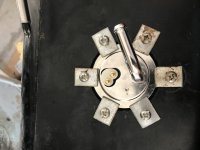 36CA2DBA-E72A-4988-AC62-087F0A41DBBD.jpg74 KB · Views: 75
36CA2DBA-E72A-4988-AC62-087F0A41DBBD.jpg74 KB · Views: 75 -
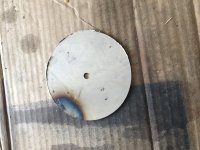 6039357B-67EE-483C-8114-9A0FB75B3396.jpg124.1 KB · Views: 44
6039357B-67EE-483C-8114-9A0FB75B3396.jpg124.1 KB · Views: 44 -
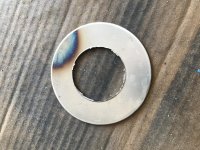 FF3FD089-0D0C-424A-810B-C6E7E18CC65D.jpg175 KB · Views: 58
FF3FD089-0D0C-424A-810B-C6E7E18CC65D.jpg175 KB · Views: 58 -
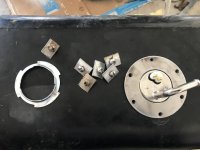 0EA5B0E5-8BE7-432C-A40F-9A9AEDB944AF.jpg77.8 KB · Views: 65
0EA5B0E5-8BE7-432C-A40F-9A9AEDB944AF.jpg77.8 KB · Views: 65 -
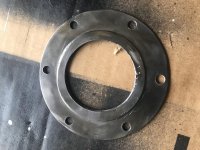 C7B2F4B8-478B-42C1-BCDC-8A1F8A0B2758.jpg138.1 KB · Views: 77
C7B2F4B8-478B-42C1-BCDC-8A1F8A0B2758.jpg138.1 KB · Views: 77 -
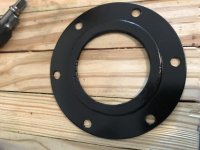 89A1E5EC-11A5-4192-8C89-84F9173898A5.jpg70.2 KB · Views: 58
89A1E5EC-11A5-4192-8C89-84F9173898A5.jpg70.2 KB · Views: 58 -
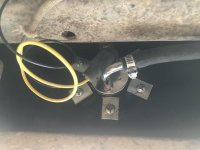 B4DD26CC-9ECD-4C41-981F-AB4A622846B1.jpg65.6 KB · Views: 76
B4DD26CC-9ECD-4C41-981F-AB4A622846B1.jpg65.6 KB · Views: 76 -
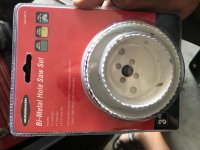 6932D177-46E8-406B-A21D-3013BC636268.jpg86.1 KB · Views: 79
6932D177-46E8-406B-A21D-3013BC636268.jpg86.1 KB · Views: 79










